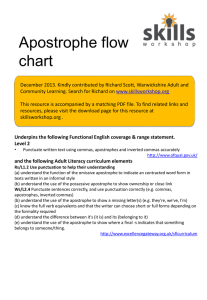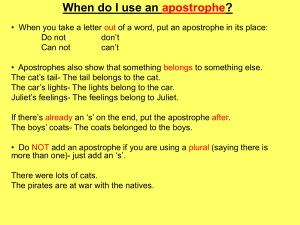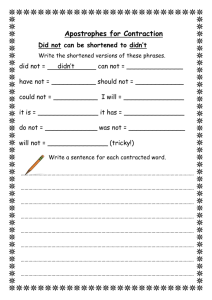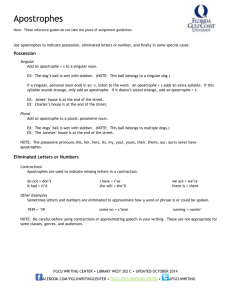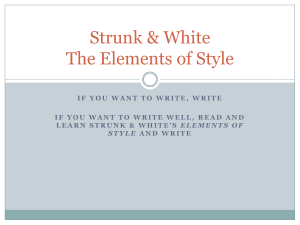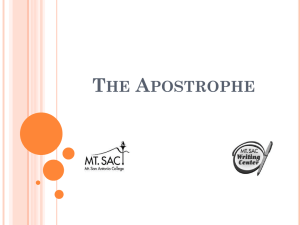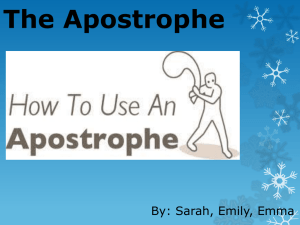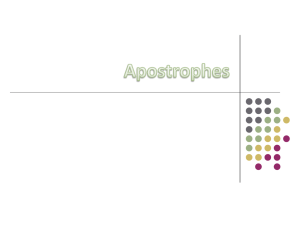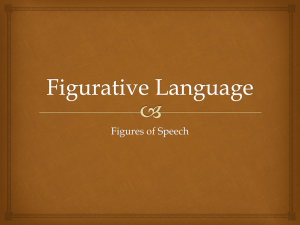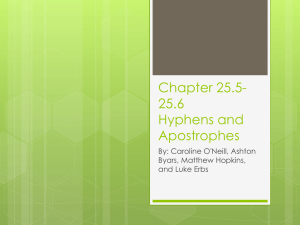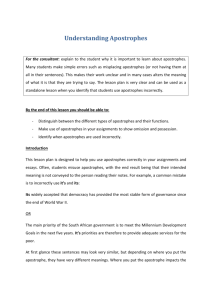Literacy.ppt - Bungay High School
advertisement
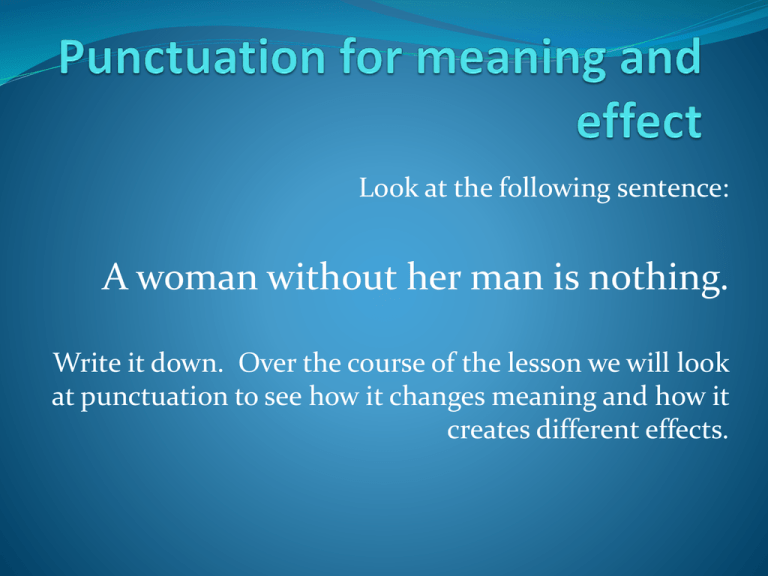
Look at the following sentence: A woman without her man is nothing. Write it down. Over the course of the lesson we will look at punctuation to see how it changes meaning and how it creates different effects. Capital letters and full stops. So you think you know it already – and you should, but still many of you don’t use a capital letter at the beginning of a sentence or a full stop at the end. Here are a series of simple sentences. Copy them down and punctuate them properly. it was a lovely day the family decided to go for a picnic to Sea Palling on the North Norfolk coast they took a really big hamper full of yummy food there were tuna salad sandwiches, hard boiled eggs, crisps and drinks for everyone the dog came too and got so excited that he nearly went to the toilet in the car It was a lovely day. The family decided to go for a picnic to Sea Palling on the North Norfolk coast. They took a really big hamper full of yummy food. There were tuna salad sandwiches, hard boiled eggs, crisps and drinks for everyone. The dog came too and got so excited that he nearly went to the toilet in the car. Marks out of 10 When else should you use a capital letter? For proper nouns (names of people, places, special events and names of novels, poems, plays or films). Even the word I, when we refer to ourselves, should be a capital letter because it’s a name we give ourself. Add the capital letter… tomorrow is my birthday, i will be 23. we are going to see ‘american beauty’, the sam mendez film, at the cinema. the poem is called ‘to a mouse’ by robert burns. Add the capital letter… Tomorrow is my birthday, I will be 23. We are going to see ‘American Beauty’, the Sam Mendez film, at the cinema. The poem is called ‘To a Mouse’ by Robert Burns. Marks out of 12 Commas, semi-colons and colons: This is a comma - , why do we use them? To create a pause in a sentence. However, we must be mindful of where we put it because it can change the meaning. What is this thing called love? What, is thing called love? What is this thing called, love? Commas, semi-colons and colons: Look at this sentence: Eats shoots and leaves. Where else can the comma go to change the meaning? Eats, shoots and leaves. Commas, semi-colons and colons: Commas can also be used to separate items in a list: There were tuna salad sandwiches, hard boiled eggs, crisps and drinks for everyone. Really only good for short lists though. For longer lists, you need the semi-colon and the colon. Like this… There were several things she liked about him: his hair; his sense of humour; his almost terminal good nature; his fascination with historical trivia and his fantastic physique. You can make a much longer list with the use of colons and semi colons as you can see. Colons and Semi-colons You can also use a colon for impact in your writing. Like this… There was only one thing in the world that would cheer her up now: chocolate. He obeyed his first instinct: run. Now… Return to your first sentence and see if you can find ways to make it mean something else through the use of punctuation. A woman without her man is nothing. Try this: A woman: without her, man is nothing. 2. Apostrophes When are they used? 1. To show possession To show a contraction (or missing letters in a shortened word) Possessive apostrophes The dog’s dangly bits. We know where the apostrophe comes because we always ask who the object belongs to. The apostrophe always comes after the correct answer. Who owns the dangly bits? The dog. Therefore the apostrophe comes after the word dog and before the letter ‘S’. Practice the possessive apostrophe. The bees knees. Who owns the knees? The bee. Where does the apostrophe go? The bee’ s knees. *********************************************************** What if there were more than one bee? Who would the knees belong to then? The bees. Where would we put the apostrophe now? The bees’ knees. This tells your reader that there is more than one bee and they all own knees! Try some on your own now… Possessive apostrophe singles and plurals The boys bikes. (more than one boy) The girls skirt. (one girl) The childrens ball. The foxs den. The Earths core. The mens room. The teachers staff room. (more than one teacher) Add the apostrophe in the correct place. 1. 2. 3. 4. 5. 6. 7. How did you do? 1. 2. 3. 4. 5. 6. 7. The boys’ bikes. (more than one boy) The girl’s skirt. (one girl) The children’s ball. The fox’s den. The Earth’s core. The men’s room. The teachers’ staff room. (more than one teacher) Contraction We often shorten words for convenience. In writing you will need to show how you have shortened the words with the use of an apostrophe. Cannot = can’t, the ‘n’ and ‘o’ are missing. Do not = don’t, the ‘n’ and ‘o’ are missing. Could have = could’ve, the ‘h’ and ‘a’ are missing. Practice the contraction. Shall not is shortened to shant. There are letters missing in two places here but we are only going to use one apostrophe nearest the end of the new word. Which letter will we replace? Shan’t. The ‘o’ is replaced Will not is shortened to wont. Where should the apostrophe go? Won’t. Contractions 1. 2. 3. 4. 5. 6. 7. Should have Would have Should not Could not Have not Did not Do not How did you do? 1. 2. 3. 4. 5. 6. 7. Should have = should’ve Would have = would’ve Should not = shouldn’t Could not = couldn’t Have not = haven’t Did not = didn’t Do not = don’t Good! You are all apostrophe experts now. Here’s a quick test… What is the never ever rule for apostrophes? When should apostrophes be used? Insert the apostrophe: 1. 2. The policemans hat. Dare not Just one last thing… Here is one of the most common apostrophe errors: Its and It’s. It’s really very simple … It’s means IT IS – it’s a contraction …see? Its without the apostrophe denotes possession. So this is the only instance where we don’t need a possessive apostrophe because it’s too confusing! Geddit?! So … What do we know about apostrophes? When should we use them? A homophone is a kind of word that, whilst it has the same sound, it has different meanings and spellings. Can you think of an example? Common homophones Their There They’re Your You’re Yore - belonging to - direction - contraction of they are - belonging to - contraction of you are - time long past So how can we remember what means what and how it is spelled correctly?! Mnemonics? A way of remembering. Try this: Their (belonging to / possessive) has the word heir in it which means they will inherit something which means they will own it!! Your turn… Think of a mnemonic for: There (direction) It has the word ‘here’ in it – also a direction. and for They’re (contraction of they are) Try saying the word to yourself as you write it – remember it is two words really. More homophones Find another word that sounds like this is spelled differently and means something else. Won Two We’re Know. What do they mean? Won – past tense of win One - a quantity Two – a quantity To - direction Too - as well or also We’re - contraction of we are Were - past tense of to be Where- direction Know - to understand something No - a refusal of something Remembering when you are writing. You either have to learn these words as a pattern, for example: Here There Where are all directional words – they all have the word ‘here’ in them. Remembering when you are writing. You could find a mnemonic for them like we did earlier. Or you could just learn them by going over and over until it sticks. However you do it, make sure you do! Quick test. Write down the correct word to fill in the blank. They’re / there/ their We went to the local park, it was nice th------. The children took th------ ball to the park. The children played well together, th------ nice children. No / Know? I didn’t ------- you could get different coloured hair dyes. I didn’t want my hair coloured anyway, so I told him -------. Where / were / we’re ---------- going to the park. Do you want to come? -------- is your mum, I will ask her. -------- you planning to do something else instead? Answers There 2. Their 3. They’re 4. Know 5. No 6. We’re 7. Where 8. Were 1. Apostrophe revisit. Can you remember where the apostrophe goes? The dogs dangly bits. I cant come out today. The childrens ball. Its cold today. Lets go to the seaside. The boys bikes. (more than one boy) Answers Dog’s Can’t Children’s It’s Let’s Boys’ Here’s test with homophones and apostrophes. Just write down the correct words that fit into these sentences. Th-------- going to the seaside in th------- mothers car. It was warmer th------ than at home. In the hamper was the little girls swimming costume and the boys bucket and spade. “Y------- going to have a lovely day” said th----- mother. “Well take a picnic for y--------- lunch.” There are NINE words that need to be filled in or corrected Answers 1. 2. 3. 4. 5. 6. 7. 8. 9. They’re Their There Girl’s Boy’s You’re Their We’ll Your Remember Learn basic punctuation Learn Apostrophes Learn homophones

